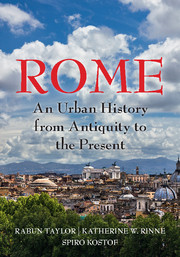Book contents
- Frontmatter
- Dedication
- Epigraph
- Contents
- List of Illustrations
- Acknowledgments
- Map
- INTRODUCTION
- 1 A BEND IN THE RIVER
- 2 A STORYBOOK BEGINNING
- 3 IDEOLOGICAL CROSSFIRE
- 4 BIG MEN ON THE CAMPUS
- 5 RES PUBLICA RESTITUTA
- 6 MEMORIALS IN MOTION: SPECTACLE IN THE CITY
- 7 THE CONCRETE STYLE
- 8 REMAKING ROME'S PUBLIC CORE: I
- 9 REMAKING ROME'S PUBLIC CORE: II
- 10 CRISIS AND CONTINUITY
- 11 RUS IN URBE: A GARDEN CITY
- 12 ADMINISTRATION, INFRASTRUCTURE, AND DISPOSAL OF THE DEAD
- 13 MAPPING, ZONING, AND SEQUESTRATION
- 14 TETRARCHIC AND CONSTANTINIAN ROME
- 15 TROPHIES AND TITULI: CHRISTIAN INFRASTRUCTURE BEFORE CONSTANTINE
- 16 WALLS MAKE CHRISTIANS: FROM FOURTH TO FIFTH CENTURY
- 17 A TALE OF TWO ROMES
- 18 THE ROME OF GOTHS AND BYZANTINES
- 19 CHRISTIAN FOUNDATIONS
- 20 FROM DOMUS LATERANI TO ROMANUM PALATIUM
- 21 THE LEONINE CITY: ST. PETER'S AND THE BORGO
- 22 VIA PAPALIS, THE CHRISTIAN DECUMANUS
- 23 THE URBAN THEATERS OF IMPERIUM AND SPQR
- 24 HOUSING DAILY LIFE
- 25 CHAOS IN THE FORTIFIED CITY
- 26 THE TIBER RIVER
- 27 HUMANIST ROME, ABSOLUTIST ROME (1420–1527)
- 28 PLANNING COUNTER REFORMATION ROME
- 29 PROCESSIONS AND POPULATIONS
- 30 MAGNIFICENT PALACES AND RHETORICAL CHURCHES
- 31 NEOCLASSICAL ROME
- 32 PICTURING ROME
- 33 REVOLUTION AND RISORGIMENTO
- 34 ITALIAN NATIONALISM AND ROMANITÀ
- 35 A CITY TURNED INSIDE OUT
- Glossary of Persons, Places, and Terms
- Works Cited
- Index
5 - RES PUBLICA RESTITUTA
Published online by Cambridge University Press: 05 July 2016
- Frontmatter
- Dedication
- Epigraph
- Contents
- List of Illustrations
- Acknowledgments
- Map
- INTRODUCTION
- 1 A BEND IN THE RIVER
- 2 A STORYBOOK BEGINNING
- 3 IDEOLOGICAL CROSSFIRE
- 4 BIG MEN ON THE CAMPUS
- 5 RES PUBLICA RESTITUTA
- 6 MEMORIALS IN MOTION: SPECTACLE IN THE CITY
- 7 THE CONCRETE STYLE
- 8 REMAKING ROME'S PUBLIC CORE: I
- 9 REMAKING ROME'S PUBLIC CORE: II
- 10 CRISIS AND CONTINUITY
- 11 RUS IN URBE: A GARDEN CITY
- 12 ADMINISTRATION, INFRASTRUCTURE, AND DISPOSAL OF THE DEAD
- 13 MAPPING, ZONING, AND SEQUESTRATION
- 14 TETRARCHIC AND CONSTANTINIAN ROME
- 15 TROPHIES AND TITULI: CHRISTIAN INFRASTRUCTURE BEFORE CONSTANTINE
- 16 WALLS MAKE CHRISTIANS: FROM FOURTH TO FIFTH CENTURY
- 17 A TALE OF TWO ROMES
- 18 THE ROME OF GOTHS AND BYZANTINES
- 19 CHRISTIAN FOUNDATIONS
- 20 FROM DOMUS LATERANI TO ROMANUM PALATIUM
- 21 THE LEONINE CITY: ST. PETER'S AND THE BORGO
- 22 VIA PAPALIS, THE CHRISTIAN DECUMANUS
- 23 THE URBAN THEATERS OF IMPERIUM AND SPQR
- 24 HOUSING DAILY LIFE
- 25 CHAOS IN THE FORTIFIED CITY
- 26 THE TIBER RIVER
- 27 HUMANIST ROME, ABSOLUTIST ROME (1420–1527)
- 28 PLANNING COUNTER REFORMATION ROME
- 29 PROCESSIONS AND POPULATIONS
- 30 MAGNIFICENT PALACES AND RHETORICAL CHURCHES
- 31 NEOCLASSICAL ROME
- 32 PICTURING ROME
- 33 REVOLUTION AND RISORGIMENTO
- 34 ITALIAN NATIONALISM AND ROMANITÀ
- 35 A CITY TURNED INSIDE OUT
- Glossary of Persons, Places, and Terms
- Works Cited
- Index
Summary
IDENTIFYING HIMSELF AS “FIRST CITIZEN” (PRINCEPS), AUGUSTUS HAD THE common touch, conveying at least the semblance of modesty and accessibility. His house on the Palatine was not lavish by aristocratic standards, though this point is often exaggerated: it probably matched any other in that exclusive neighborhood, enjoying a lordly overlook on the Circus Maximus and Aventine and abutting the venerable sanctuary of Cybele, a goddess favored by the patrician elite. In 28 B.C.E. he dedicated a new temple on the other side of his house, this one to Apollo; to it was attached a library that would gain enduring fame. His residence could hardly have been less secluded, wedged between two public religious sites overlooking the largest venue of spectacle in Rome. But visibility and nominal accessibility suited his style. Throughout his career he seems to have augmented his landholdings on the Palatine, perhaps including most of its northern quadrant, which his successors Tiberius and Caligula would develop into a vast new palace block. His holdings crept southward down the slope, connecting the residence to a new imperial box in the circus, which he also expanded and beautified.
Once he was firmly in power, Augustus styled himself the savior and restorer of the old republic. His soft, conciliatory style of autocracy led him to ardently cultivate the fiction of res publica restituta, “republic restored”: thus the unruly old Forum did not escape his silken backhand. The restoration was purely curatorial. The viscera were removed, but the exterior was rehabilitated in amplified glory. Damaged by repeated fires but refreshed by the emperor and his aristocratic allies, the Forum looked better by the end of his rule than ever before (see Figs. 22, 24). Caesar's project on the northwest end was complete. Gleaming new basilicas lined both long sides; the Basilica Aemilia's breathtaking polychrome marble nave now displayed a sculptural frieze depicting Roman foundation myths. Resplendent temples at each end, those of Concordia and the deified Julius Caesar (Divus Julius), were crammed with plundered artworks on display. The ancient Temples of Saturn and Castor and Pollux were rebuilt to the highest standards. But functionally, the Forum was losing its civic relevance – becoming more a museum, less an engine, of Roman self-determination and expansionism.
- Type
- Chapter
- Information
- RomeAn Urban History from Antiquity to the Present, pp. 43 - 51Publisher: Cambridge University PressPrint publication year: 2016



